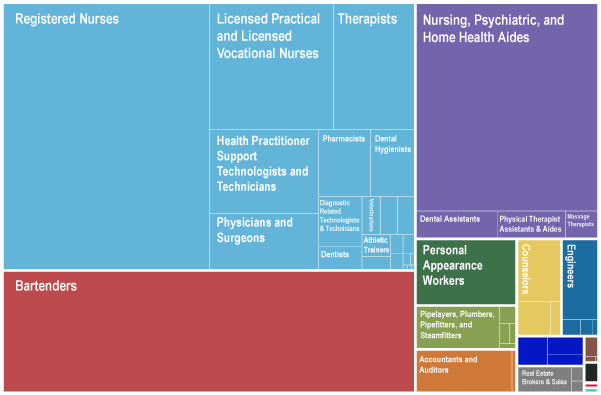Occupation Assignment Engine helps fill knowledge gaps

Data from the Indiana Public Licensing Agency were useful in developing the new Occupation Assignment Engine, which assigns occupations to employment records.
Improving the quality of workforce data has been a years-long focus of the Research and Analysis Division of the Indiana Department of Workforce Development. Working with the Indiana Business Research Center (IBRC), they have developed an Occupation Assignment Engine, which uses advanced statistical methods, models and processes to assign occupations to payroll employment records.
Today, we can report significant success in utilizing Public Licensing Agency (PLA) records as one of the more important inputs to the engine (see Table 1). Since, according to the PLA, nearly one in seven Hoosier workers have a professional or occupational license, we began integrating that licensure data with the result that fully 10 percent of the payroll wage records can be matched with both an occupation and a PLA license or certification.
Table 1: PLA license statistics
| Description | Number |
|---|---|
| Individuals with an active Indiana PLA license | 468,313 |
| PLA licensed individuals on an Indiana payroll | 292,481 |
| Percent of PLA license holders on an Indiana payroll | 62% |
| PLA licensed individuals with an SOC occupation assignment for at least one quarter | 291,496 |
| Percent of individuals with more than one active license | 29% |
Source: Indiana Business Research Center
A significant number of occupations have been assigned in the health care fields, including registered nurses, physicians and surgeons, and nursing, psychiatric and home health aides. Other occupations that were successfully assigned based on licensure included bartenders, accountants, engineers, plumbers, counselors and personal appearance workers (such as hairdressers and barbers).
Note that work is underway using a separate source for attorneys and we hope to obtain license data for educators in the near future; neither of those license types are included in the PLA database. We have also been successful in matching public employment job titles to employment records and assigning an occupation code. We will cover that work in a future article.
The “tree map” in Figure 1 shows the relative proportion of the license-based occupations.Determining the dates a license is active
The process to use an individual’s license as a proxy for their occupation began with cleaning the PLA database. Many licensing boards that provide data to PLA have their own license status categories, so we developed a condensed, standardized list of license status values based upon information available from the licensing boards. That standard list of status values was ranked in order of importance to indicate which license should be given priority in the occupation assignment process if there were several licenses held by the same individual (see Table 2). For example, the priority ranking will consider a home inspector license with an active status rank to be of a higher priority than a real estate agent license with an expired status rank from the same individual.
Table 2: License status values
| Standardized license status | Priority rank | Non-standard status values assigned to category |
|---|---|---|
| Active | 1 | Active |
| Conditionally active | 2 | Conditional, Probation, Probation/Referral, Valid to Practice While Reviewed |
| Superseded | 3 | Superseded |
| Not practicing | 4 | Current/Not Practicing, Retired |
| Expired | 5 | Dead, Expired, Expired/Holding Application, Expired/Non-Renewable, Inactive, Inactive/Expired, Inactive/Probation, Null and Void, Probation/Expired, Referral/Expired, Registry History, Storage, Unassigned/Expired, Voluntary Surrender |
| Suspended | 6 | Emergency Suspension, Suspended |
| Revoked | 7 | Finding, Rescinded, Revoked |
| Not awarded | 8 | Abandoned Application, Application Denied, Cancelled, Deleted Application, Failed Exam, Renewal Denied, Withdrawn Application |
| Pending application | 9 | Pending Application, Reinstatement Pending |
| Unassigned | 99 | Unassigned |
Source: Indiana Business Research Center
Assigning a Standard Occupation Code
The occupations associated with each type of license and the industries of employment associated with each occupation were evaluated. If an individual holding an active license was employed in an industry expected with their license, and there was only one potential occupation associated with that license, the individual was assigned that occupation.
If there were several potential occupations that were similar based upon the license and industry of employment, then the individual was assigned a less-specific occupation that included all of the more specific detailed occupations. For example, an individual with an active physician license will have a list of seven potential occupation codes associated with that license:
- 29-1061 Anesthesiologists
- 29-1062 Family and General Practitioners
- 29-1063 Internists, General
- 29-1064 Obstetricians and Gynecologists
- 29-1065 Pediatricians, General
- 29-1066 Psychiatrists
- 29-1069 Physicians and Surgeons, All Other
If that same individual works in the general medical and surgical hospitals industry, they will have an industry match to all seven of the potential occupation codes. While it is not possible to determine which detailed occupation they hold based on the available information, it is possible to assign them a general occupation code (29-1060: Physicians and Surgeons) that includes all of the potential detailed occupation codes.
For the remaining unassigned active license holders, we calculated annualized wage data to eliminate potential occupation assignments with non-likely wages. The occupation with the closest average salary range based upon the occupation and industry combination was assigned to the individual.
For more information on the Occupation Assignment Engine developed by the IBRC, email ibrc@iu.edu and ask for Carol Rogers or Thea Evans.

